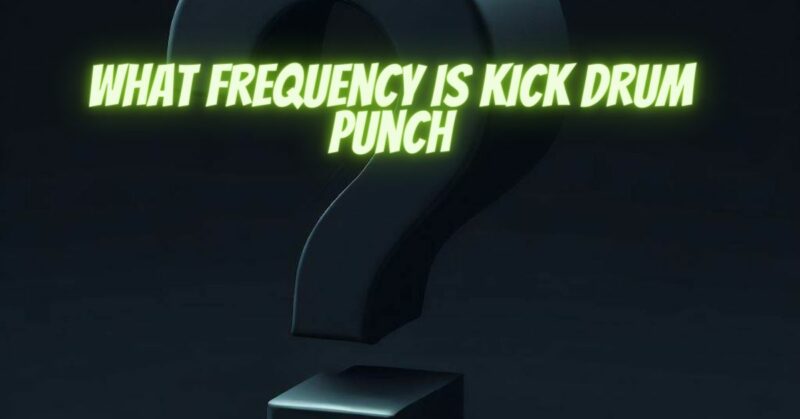The kick drum, often referred to as the heartbeat of a song, is a crucial element in shaping the rhythm and dynamics of music. One of its defining characteristics is the “punch” it delivers, which is responsible for the visceral impact felt by listeners. In this article, we’ll delve into the world of kick drum punch, exploring the frequencies, techniques, and factors that contribute to its powerful presence in music.
- Defining Kick Drum Punch
- Punch: In the context of a kick drum, “punch” refers to the sharp, dynamic, and forceful transient sound that occurs when the beater strikes the drumhead. It is a percussive burst of sound that grabs the listener’s attention and drives the rhythm of a song.
- Frequency Range for Kick Drum Punch
- Fundamental Frequency: The fundamental frequency of a kick drum, which contributes significantly to its punch, typically falls within the range of 40Hz to 100Hz. This frequency range is responsible for the thump and impact that listeners feel in their chests.
- Low-Mid Frequencies: Additionally, the low-mid frequencies, which range from about 100Hz to 400Hz, also play a vital role in creating a punchy kick drum sound. These frequencies provide body and definition to the kick.
- Techniques for Achieving Kick Drum Punch
- Microphone Placement: Capturing the punch of a kick drum starts with microphone placement. Placing a microphone inside the kick drum, known as the “inside kick” technique, can emphasize the beater’s impact sound and result in a punchier sound. Alternatively, positioning the microphone just outside the drum’s sound hole can capture more of the resonance and body.
- Tuning: Properly tuning the kick drum is essential for achieving punch. Tensioning the drumhead to the desired pitch can help emphasize the fundamental frequency while allowing for a controlled decay.
- Beater Selection: The choice of beater used in a kick drum pedal can significantly affect punch. A hard or plastic beater tends to produce a sharper attack, emphasizing the punch, while a softer or felt beater can result in a smoother, less punchy sound.
- Dynamic Playing: A skilled drummer can enhance the punch of a kick drum through dynamic playing techniques, such as accenting certain beats or using double strokes to emphasize the attack.
- Audio Processing and Equalization
- Compression: Audio compression can be applied to the kick drum to control its dynamic range and emphasize the punch. A well-configured compressor can make the initial transient sound more pronounced while maintaining a consistent overall volume.
- Equalization (EQ): Careful EQing is crucial for shaping the punch of a kick drum. Boosting the frequencies in the 40Hz to 100Hz range and, to some extent, the low-mid frequencies can enhance the kick’s impact.
- Genre and Artistic Intent
- Genre Variation: The desired punch of a kick drum can vary depending on the music genre. In heavy rock or metal, a thunderous and highly pronounced punch is often sought after, while in jazz or acoustic settings, a more subtle and controlled punch may be preferable.
- Creative Freedom: Musicians and producers have the creative freedom to tailor the kick drum punch to match the mood and energy of a song. This flexibility allows for the creation of unique and impactful sounds across different musical styles.
The kick drum punch is a defining element in music, contributing to the rhythm, dynamics, and overall impact of a song. Understanding the frequency range, techniques, and audio processing methods used to achieve punch allows musicians and producers to harness this powerful tool in their music production. Whether it’s the chest-thumping punch of a rock anthem or the subtle precision of a jazz groove, the art of kick drum punch is a dynamic and essential aspect of music creation.

